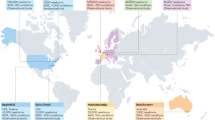Abstract
Clinical applications of next-generation sequencing are growing at a tremendous pace. Currently, the largest application of genetic testing in medicine occurs with newborn screening through state-mandated public health programs, and there are suggestions that sequencing could become a standard component of newborn care within the next decade. As such, newborn screening may appear to be a logical starting point to explore whole genome and whole exome sequencing on a population level. Yet, there are a number of ethical, social, and legal implications about the use of a mandatory public health screening program that create challenges for the use of sequencing technologies in this context. Additionally, at this time we still have limited understanding and strategies for managing genomic data, supporting our conclusion that genome sequencing is not justified within population-based public health programs for newborn screening.
Similar content being viewed by others
References
Papers of particular interest, published recently, have been highlighted as: • Of importance
• Dondorp W, de Wert G, Bombard Y, et al. Non-invasive prenatal testing for aneuploidy and beyond: challenges of responsible innovation in prenatal screening. Eur J Hum Genet. 2015;23:1438–50. This highlights the ethical challenges of genome wide sequencing prenatally and raises similar challenges for genome wide sequencing in newborn screening.
Soden SE, Saunders CJ, Willig LK, et al. Effectiveness of exome and genome sequencing guided by acuity of illness for diagnosis of neurodevelopmental disorders. Sci Transl Med. 2014;6:265ra168.
Health NIo. Newborn screening in the genomic era: setting a research agenda. Newborn screening in the genomic era: setting a research agenda. Rockville: National Institute of Health; 2010.
Health NIo. NIH program explores the use of genomic sequencing in newborn healthcare. 2013.
Bamshad MJ, Ng SB, Bigham AW, et al. Exome sequencing as a tool for Mendelian disease gene discovery. Nat Rev Genet. 2011;12:745–55.
Kitzman JO, Snyder MW, Ventura M, et al. Noninvasive whole-genome sequencing of a human fetus. Sci Transl Med. 2012;4:137.
• Botkin JR, Belmont JW, Berg JS, et al. Points to consider: ethical, legal, and psychosocial implications of genetic testing in children and adolescents. Am J Hum Genet. 2015;97:6–21. This is an excellent review of the ethical, legal and psychosocial implications of genome wide sequencing in children and how it impacts the family and future reproductive decisions.
Feuchtbaum L, Carter J, Dowray S, Currier R, Lorey F. Birth prevalence of disorders detectable through newborn screening by race/ethnicity. Genet Med. 2012;14:937–45.
Lewis M. Newborn screening controversy: past, present, and future. JAMA Pediatr. 2014;168:199–200.
Feutchbaum L, Cunningham G, Sciortino S. Questioning the need for informed consent: a case study of California’s experience with a pilot newborn screening research project. J Empir Res Hum Res Ethic. 2007;3:3–14.
Fant KE, Clark SJ, Kemper AR. Completeness and complexity of information available to parents from newborn-screening programs. Pediatrics. 2005;115:1268–72.
Fox C, Lloyd-Puryear M, Mann M. Serving the family from birth to the medical home. Newborn screening: a blueprint for the future—a call for a national agenda on state newborn screening programs. Pediatrics. 2000;106:389–422.
Wilcken B. Newborn screening: gaps in the evidence. Science. 2013;342:197–8.
Wilson J, Junger G. Principles and practice of screening for disease. Public health papers #34. Geneva: World Health Organization; 1968.
Andermann A, Blancquaert I, Beauchamp S, Dery V. Revisiting Wilson and Jungner in the genomic age: a review of screening criteria over the past 40 years. Bull World Health Organ. 2008;86:317–9.
Lipstein EA, Perrin JM, Waisbren SE, Prosser LA. Impact of false-positive newborn metabolic screening results on early health care utilization. Genet Med. 2009;11:716–21.
• Green RC, Berg JS, Grody WW, et al. ACMG recommendations for reporting of incidental findings in clinical exome and genome sequencing. Genet Med. 2013;15:565–74. This is foundational article about what type of incidental findings should be returned to adults as well as children.
Fallat ME, Katz AL, Mercurio MR, Moon MR, Okun AL, Webb SA, Freedenberg DL. Ethical and policy issues in genetic testing and screening of children. Pediatrics. 2013;131:620–2.
Author information
Authors and Affiliations
Corresponding author
Additional information
This article is part of the Topical Collection on Ethics in Medical Genetics.
Rights and permissions
About this article
Cite this article
Botkin, J.R., Rothwell, E. Whole Genome Sequencing and Newborn Screening. Curr Genet Med Rep 4, 1–6 (2016). https://doi.org/10.1007/s40142-016-0084-3
Published:
Issue Date:
DOI: https://doi.org/10.1007/s40142-016-0084-3




